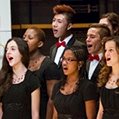Five EMSB Schools to Compete In Robocup International
A group of seventh graders will represent Vincent Massey Collegiate in Rosemount. They have created a robotic Rescue Vehicle!
A team of Grade 6 students from Pierre Elliott Trudeau Elementary School, also in Rosemount, will demonstrate Jimmy the Robot, a comedian. They've also come up with a robot that plays piano.
Dalkeith Elementary School in Anjou will bring two dancing robots and a robot DJ booth.
Merton Elementary School in Cote Saint-Luc will use a program that's never been used before in Canada!
Five fifth graders from Cedarcrest Elementary School in St. Laurent have spent a lot of time putting together their robot that shows off its rescue skills.
VINCENT MASSEY COLLEAGIATE!
Daniel Bouchard, 13, Felix Alexander Horonczyk-Panez, 13, Luca DiPasquale-Farina, 13, and Luca Messina, 12, are the brains behind the small-scale robotic vehicle. They've been working on it for months. "We have Lego kits," said Bouchard, "and there's motors and hardware that control the motors. First step is to put together the robot, add motors, add wheels. Then we have to program it."
Bouchard and his teammates programmed their robotic vehicle to follow a black line on a path. It can climb hills, avoid obstacles and even lift them. It uses sensors to navigate. And once it's off and running, it's on its own. There's no remote control required since it's been programmed to operate itself!
Messina, the youngest in the group, didn't have as much experience as the others when he joined the team. But he's a big part of it, has learned a lot, and is very proud of their accomplishment.
"This robot, I'm pretty proud," Messina said, "because we worked together as a team. We had some ups and downs but managed to get it done and it (the robot) follows a line...We think we have a chance of winning but then again there's still a lot of improvements we can make, nothing's perfect."
On a larger scale, this type of rescue vehicle can be used for real-life applications. "It could be for de-activating bombs or climbing or things like that to rescue people," said Horonczyk-Panez.
Some of the Vincent Massey students competed at RoboCup in Japan last year, including DiPasquale-Farina. It was an experience he'll never forget. "There's a lot of stuff you can learn from," he said. "(Winning), maybe not this year but we could learn what to expect and do better. We possibly could do it."
Vincent Massey physics and science teacher Sabrina Mancuso is the team's manager and she explains that the 7th graders recently won a regional event that propelled them to this month's international competition. "It's most of the school year for them to complete the project," she said. "A lot of the work happens very intensely but, yes, they work on it all year."
Lab technician Angelo Cianci couldn't say enough about the team he helped guide. "They were amazing," he said. "They wrote the program all by themselves, they were excellent."
These kids have already been very successful. And now they're ready to take on their latest challenge at RoboCup!
PIERRE ELLIOTT TRUDEAU ELEMENTARY SCHOOL
Don't be confused by Jimmy the Robot. He may act and even look like Jimmy Fallon, but he is a robot built by Grade 6 students from Pierre Elliott Trudeau Elementary School in Rosemount and will be on display at the 22nd RoboCup International Competition and Symposium at the Palais des congres de Montreal from June 18 to June 21.
In fact, Catalka Hatt Sustam, Raphael Sutherland-Ortega, Charlotte Renaud, Alessandro Chiby and John Wang also created a piano-playing robot! Jimmy the Robot will tell the jokes and the piano handles the music.
Jimmy has a iPad for a face and another student lent his voice with a pre-recorded script that is programmed into the robot so it can speak.
Charlotte, 12 years old, is the team's captain. She coded the program to make Jimmy speak "and to make the eyes open and close. It took a lot of time because the program is super-long. I had to put in every little detail. It was sometimes challenging. There was a problem and I didn't know where to find it and you have to search."
But months of hard work have paid off for the team of 12-year-olds. One group worked mainly on Jimmy the Robot and another group focused on creating the piano-playing robot.
"It was obviously not the easiest thing in the world to do, really not," said Catalka. "Probably the most difficult thing I've done."
Teacher Patrick Charland is the team's manager. "We tried to create a robot with personality, a funny robot that can move, a charismatic-like robot," he said.
Jimmy's face is created using animation. The kids used wood and aluminum for the body and it's a light-weight creation. The piano robot has a pair of hands playing the keyboard.
Since remote controls are not allowed during the competition, every movement has to be programmed in advance. And these students are working up to the last minute to make sure everything runs smoothly.
DALKEITH ELEMENTARY SCHOOL IN ANJOU
Kids love to dance and these kids from Dalkeith Elementary School in Anjou combined their love of dance and robotics to create two dancing robots and a robot DJ booth. Their inventions can be seen at the 22nd RoboCup International Competition and Symposium.
Teacher Sandra Trevisonno explains that the robots will engage in a dance battle, sort of. "They dance against each other, they each have their own kind of dance routine," she said. "And there should be a winner at the end but the kids decided to make it so that it's a friendly competition and the robots shake hands at the end."
How do they shake hands? With 3D-printed hands. These Grade 6 students thought of everything! They use sophisticated programs to run their robots but also use everyday items for their creations, such as cardboard to help build the robot DJ booth. It doesn't actually play music. The sound comes from an external source but the impression is given that the music comes from within the booth.
Aside from the hardware, the dancing robots were made from LEGO kits. It's taken most of the school year for the group of 12 year old students to go from conceiving the ideas to producing their robots.
The robots are programmed to follow a series of black lines. "We start the program and we dance, and that's it," said Kylie Nguyen.
Whose idea was it to come up with a dance battle? "We all thought of it," said Megan Ruscitto. "At the beginning, in the first two days, we had nothing and then we just all thought, 'Why don't we do a dance battle?' We wanted to make it a friendly dance battle and realize that everyone's a winner."
And how difficult was it to create their robots? "It was pretty hard," said Ruscitto, "but we got through it."
Teacher and team co-manager Julia Galteri couldn't say enough about their accomplishments, saying she is "immensely proud! It's really impressive to see how far they've come."
MERTON ELEMENTARY SCHOOL IN CÔTE SAINT-LUC
A group of students from Merton Elementary School in Cote Saint-Luc are set to make the Canadian debut of the RoboCup Junior Co-Space Rescue Challenge at the 22nd RoboCup International Competition and Symposium at the Palais des congres de Montreal from June 18 to June 21.
The rescue program is virtual. You'll see robots avoid obstacles and do various chores, such as picking up items and dropping them into a bin. But it's all on-screen.
Debbie Adams, the students' mentor, said it will be the first time this program, created in Singapore, is being used in Canada! "It's never been part of our competition...we have never used this software in Montreal, anywhere in Canada."
Adams and the team of students attended a two-day workshop. And the program was installed on their laptops only three weeks ago! Adams adds that when she learned of the opportunity to use this program, she jumped on it. "When I heard about it, I said, 'Please, me.'"
The rescue challenge involves two robots competing against each other. They are required to pick up coloured squares and then drop them into a collection area to win points.
"You have two different robots with flashing lights," Adams said. "They have ultra-sonic sensors on them, which detect distance. There's one in front and two on the side. The wheels actually are where the colour sensors are. They detect where things are. They have to program it to know, using the colour sensors, when it's over (the coloured squares)," Adams said. "If they happen to go through a trap, they lose anything they're carrying."
The robots do have to avoid obstacles such as traps and walls. They can also teleport from one world to another where they can get more points. The program runs for eight minutes and the goal is to collect as many points as possible.
The Merton team is made up of four students; Grade 5 eleven year old's Danielle Ifrah and Alexander Segal. Maya Lavery-Callender and Jayden Blitzer are both twelve years old and in Grade 6.
Not having much time to work on this project was challenging, according to Jayden. "It was really hard because we learned this in the course of two days."
Maya is thrilled for her team to be the first in Canada using this program. "It's amazing," she said. "Anything that we can do is fantastic because we're the only team in Canada that's trying to do this for the first time."
Merton Elementary School has a long history of using robotics and Artificial Intelligence and their appearance at RoboCup will take their experience to the next level!
CEDARCREST ELEMENTARY SCHOOL IN ST. LAURENT
You can call them the Fab 5! Andrew Yoo, Julian Sarli, George Vogas, Gabriel Abouassaly and Stelyos Kanellopolous are five Grade 5 students from Cedarcrest Elementary School in Saint-Laurent who will compete at the 22nd RoboCup International Competition and Symposium.
This will be their first experience at the event that will host thousands of participants. The Cedarcrest students have entered the 'Rescue Mission' competition in which a robot moves around an obstacle course, trying to avoid traps.
"At RoboCup, the big, big plan is to have bumps in the road," said Robotics Facilitator Linda Batzios. "They have to avoid objects like falling trees, like a town that's been hit by a disaster. And then, the ultimate goal is to rescue the 'victims'". The 'victims' are round objects that the robot collects.
The robot is made of various parts including a EB3 Mindstorm Lego education kit, as well as sensors which allow the robot to avoid traps and identify colours. When it sees the colour green, it changes direction.
"The faster, the better," said Batzios. "This is a matter of skill and speed...We try to make it go as quick as we can."
And it's already a winner! It was fastest, 45 seconds to complete the mission, at a recent RoboCup qualifying event. But the tinkering never ends. "Every day, there's an adjustment," according to Batzios. "He worked perfectly yesterday. We turn him on today, he doesn't do what you want him to do. So we've got to constantly trouble-shoot and tweak. It's on-going."
11 year old Julian Sarli said it's almost like the robot has a mind of its own. "Because one day it works, and then we do the exact same thing the next day, and it doesn't work."
Andrew Yoo, also 11, has enjoyed the learning experience. "You get to find out new things and new ways to make it work," he said.







